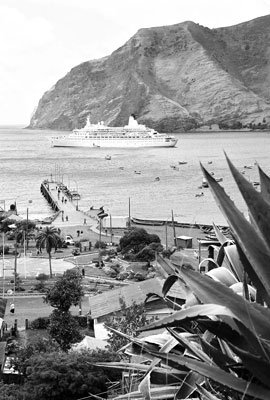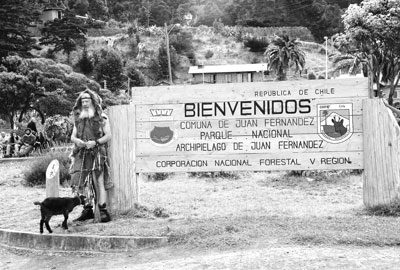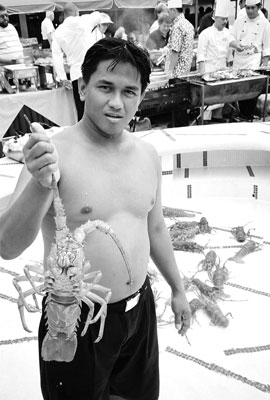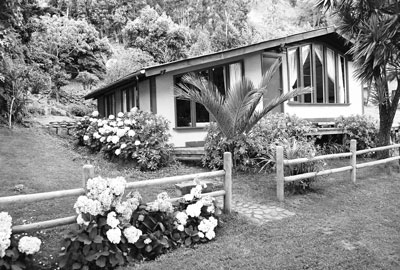Fact versus fiction on Robinson Crusoe Island
by Llewellyn M. Toulmin
Richard Henry Dana, in his classic tale “Two Years Before the Mast,” describes Robinson Crusoe Island in the South Pacific as “the most romantic spot of earth my eyes had ever seen.” Visiting the island on a cruise aboard M.V. Discovery made me think that perhaps Dana was right.
Truth is greater than fiction
Robinson Crusoe Island, originally known as Más a Tierra (“closer to land”), is part of the Juan Fernández group, named after the Spanish seaman who discovered the islands in 1574. The island gained its fame from the Daniel Defoe novel “Robinson Crusoe,” first published in 1719 and never out of print since.
Defoe had learned of the tale of Alexander Selkirk, a Scottish seaman who was voluntarily marooned on Más a Tierra from 1704 to 1709 and who survived alone on the island. Defoe was fascinated by the tale, researched it and changed the true story into the famous novel.
In the novel, Robinson Crusoe is shipwrecked on an island in the southeast Caribbean near Trinidad, survives cannibal raids, meets his faithful companion, Friday, and is rescued after an improbable 28 years. The real story and the real man are actually even more interesting.
Alexander Selkirk was born in Fife, Scotland, in 1676, the seventh son of a shoemaker. He was unruly as a child and was disciplined in church for having struck his brother, mother and father. He ran away to sea at age 19 aboard the Cinque Ports, a British privateer fighting in the War of Spanish Succession.
The vessel sailed around Cape Horn in search of Spanish treasure, but by the time the ship reached Más a Tierra, 416 miles west of Chile, Selkirk was sick of the captain and afraid that the vessel was unseaworthy. So he asked to be left ashore, and the captain readily agreed.
At the last minute, Selkirk changed his mind and begged to be taken back aboard, but the captain smugly refused. Selkirk had the last laugh, however, for the Cinque Ports later sank as he had predicted, although her annoying captain escaped.
To survive, Selkirk had only a gun, a knife, a hatchet, navigation books, a Bible and three days’ rations. This was actually less gear than the fictional Robinson Crusoe had, who was able to salvage much more from his wrecked ship. But Selkirk was very resourceful, and he built a hut, found parsley, watercress and heart of palm to eat and made fire by rubbing two sticks together.
He became dejected but turned to his Bible and found religion, and “life became one continual feast.” He got very fit and chased down and captured goats on steep, rocky hillsides for sport and food. Once, he fell off a cliff and was knocked unconscious for three days. He raised cats to fend off the rats that gnawed his feet at night.
He never met any cannibals, but he did hide in a tree to escape Spanish sailors who came ashore looking for him.
Rescued
In February 1709, after more than four years on the island, Selkirk was rescued by Woodes Rogers and William Dampier, the famous English pirates, in their vessel, the Duke. They describe Selkirk as a hairy creature clad in stinking goatskins who could hardly speak English any more from lack of use.
Despite his strange appearance, Rogers and Dampier recognized Selkirk’s navigational skills and local knowledge and offered him a post as mate. He readily accepted, and together they raided the port of Guayaquil (in what is now Ecuador), capturing 19 vessels, including a Manila galleon. In 1711 they returned to England, selling their spoils for £147,000, of which Selkirk got £800, a princely sum.
Despite his riches, Selkirk was not very happy. He moved into a cave near his mother’s house in Scotland, bewailed the trappings of “civilization” and eventually shipped out again aboard HMS Enterprise.
He died of a tropical disease in 1721, and at the probate court hearing two women appeared, each producing papers proving that she was his wife and entitled to his remaining wealth. Apparently, Selkirk took the phrase “a girl in every port” a little too literally.
Introduction to the island
I reached Robinson Crusoe Island aboard the soft-adventure vessel M.V. Discovery (Discovery World Cruises, Ft. Lauderdale, FL; phone 866/623-2689, e-mail info@mvdiscovery.com).
This graceful vessel was formerly the famous “Island Princess,” used as a backup vessel in filming the popular 1970s/80s “Love Boat” TV series. She has been thoroughly refurbished and modernized and now carries up to 650 passengers in luxury and comfort to exotic destinations in every corner of the world.
Although it is possible to fly to Robinson Crusoe Island from Chile, the flight is a bit hairy, with arrival on a short landing strip at the base of a cliff followed by a 2-hour boat ride or a 6-hour hike (no taxis, as there is no road) to the only town. A comfortable cruise ship seemed a much more attractive approach.
Going ashore, I was struck by the beauty of the steep cliffs and the tiny town of San Juan Bautista. From the ship’s tender I could see much of the island’s habitable area. The entire island is only about 40 square miles, but it is so steep that it is like a piece of crumpled paper resting on the sea. The island is green, with more trees than I expected — mostly majestic Norfolk pines and eucalyptus.
I stepped ashore at the town dock and was met, of course, by Robinson Crusoe! Clad in goatskins and with a baby goat beside him, he looked very authentic.
I wandered up the town’s wide main street made of dirt and gravel. A town square contained a statue of the wonderfully named Bernardo O’Higgins, one of the founders of Chile. Chile still governs the island group, and Chilean president Eduardo Frei Montalva renamed the two main islands Robinson Crusoe and Alexander Selkirk in 1966, hoping to draw tourists.
Next I bought the obligatory T-shirt and went into the small post office to buy some local stamps. The postman kindly offered to stamp my passport, but the ship’s purser was holding it, so I asked him to stamp a blank piece of paper with the symbol of the island and the legend “Isla Robinson Crusoe” — proof that I had visited one of the world’s most remote spots.
Island tour
A tour guide took some of the other Discovery passengers and me on a tour of the town, giving us some of the facts about the island group today: 500 inhabitants, only 10 cars, only two miles of roads, one medical clinic, one dentist, a few shops and a maximum elevation of 3,200 feet. There is a grammar school, but at age 13 children must go to the mainland for education.
We climbed up the hill overlooking the picturesque town to Fort Santa Barbara, a Spanish fortress built of rock, with 15 rusting cannons pointed out to sea. In the harbor below we could see numerous small fishing boats, which harvest large crayfish, the island’s main export.
Near the fort we inspected a series of mysterious caves cut into the cliff. Our guide said that the caves possibly were dug out by prisoners when the island was used for a time as a prison, but no one knows for sure.
We walked along the rocky beach in front of the town and were impressed with the flower gardens and attractive chalet-style cottages. (Many of these cottages are available for rental to long-term visitors at reasonable rates.) Other passengers hiked up toward El Mirador (1,853 feet above sea level) for spectacular views, and some walked along the beach to the right of the town, where they found playful fur seals lounging on the rocks.
We ended our tour with a delicious local drink, a pisco sour, at our tour guide’s house. Like most houses, it was right above the beach. As we sat and enjoyed the view, a pair of fur seals swam by and seemed to wave their flippers at us. We smiled and waved back. A fitting end to a visit to one of the most storied and romantic spots on Earth.
The ITN staff is pleased to announce that Llewellyn Toulmin is ITN’s new Cruises Editor. Watch for his first column in next month’s issue.




